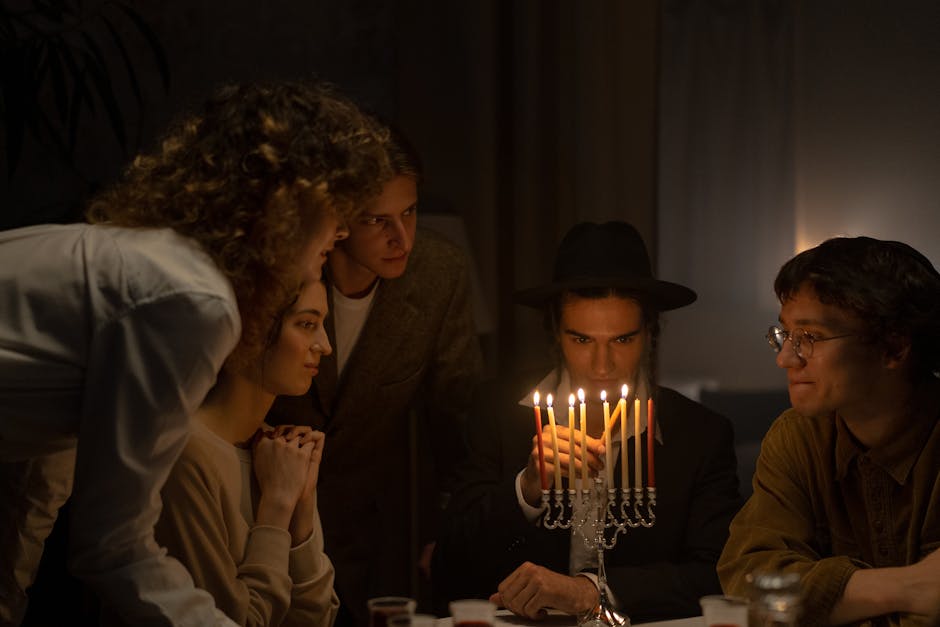Illuminate Kwanzaa Stories with the Right Candles
Candles to improve kwanzaa storytelling play a vital role in bringing the rich traditions of Kwanzaa to life. Kwanzaa, a celebration of African American heritage, is deeply rooted in storytelling and cultural remembrance. By incorporating candles specific to each principle of Kwanzaa, families can create a more immersive and meaningful storytelling experience. Whether it’s through the soft glow of the kinara or the symbolic colors of the mishumaa saba, these candles serve as focal points of unity and reflection.
To improve your Kwanzaa storytelling experience:
- Use red, black, and green candles to represent the struggle, people, and future.
- Incorporate traditional tales and folktales to deepen cultural connections.
- Engage children with interactive storytelling during candle lighting ceremonies.
I bring to this discussion the ethos of creativity and cultural celebration inherent in candle-making. Just as Kwanzaa celebrates cultural heritage, candles to improve kwanzaa storytelling provides a sensory portal to our shared stories.

Candles to improve kwanzaa storytelling vocab to learn: - candles to improve family reading rituals - literary themed candles - classic literature candles
The Significance of Candles in Kwanzaa
Candles are more than just decorative elements in Kwanzaa; they are central to the celebration's rituals and meanings. Each candle in the Kwanzaa kinara represents one of the seven principles of the Nguzo Saba, which are the foundation of the holiday. These principles guide the community towards unity, self-determination, collective work and responsibility, cooperative economics, purpose, creativity, and faith.
Candle Lighting and the Kinara
The kinara, a seven-branched candleholder, is at the heart of Kwanzaa's symbolism. It holds the mishumaa saba—the seven candles that embody the Nguzo Saba principles. Lighting these candles is a daily ritual that begins on December 26 and continues through January 1. This act is not just about illumination; it's a communal moment of reflection and learning.
-
Umoja (Unity): The black candle in the center of the kinara is lit first, symbolizing unity, the core principle that supports all others.
-
Kujichagulia (Self-Determination): The first red candle is lit on the second day, emphasizing the importance of defining oneself and speaking for oneself.
-
Ujima (Collective Work and Responsibility): A green candle is lit next, representing the commitment to building and maintaining the community together.
The sequence continues, alternating between red and green candles, each day focusing on a different principle. This progression not only lights up the room but also illuminates the path of cultural understanding and growth.
Symbolism of Colors
The colors of the candles—red, black, and green—are symbolic and meaningful. Red represents the struggle for freedom, black stands for the people, and green signifies the future and hope. These colors are drawn from the Pan-African flag, reflecting a connection to a broader African heritage.
By lighting these candles, families and communities participate in a shared ritual that honors their past and looks forward to their future. It is a time to gather, reflect, and pass down stories that reinforce cultural values.
Incorporating candles to improve Kwanzaa storytelling deepens the celebration's impact, creating a space where stories are not just told but felt and experienced. Through the glow of each candle, the principles of Nguzo Saba come to life, fostering a sense of unity and cultural pride.

As you light each candle, remember the stories and traditions they represent. This ritual is a powerful reminder of the community's strength and the ongoing journey of cultural empowerment.
Candles to Improve Kwanzaa Storytelling
Candles play a crucial role in enhancing the Kwanzaa storytelling experience. The mishumaa saba, or the seven candles, are more than just a source of light. They are a gateway to the rich stories and traditions that define Kwanzaa.
Mishumaa Saba and the Principles
Each candle in the mishumaa saba represents one of the seven principles of the Nguzo Saba. These principles are the backbone of Kwanzaa, and lighting each candle is a way to bring these values to life. Here's a quick breakdown of how each candle aligns with a principle:
-
Umoja (Unity): The black candle, lit first, symbolizes unity, the foundation of all principles. This sets the stage for stories that emphasize togetherness.
-
Kujichagulia (Self-Determination): The first red candle, representing self-determination, inspires stories of identity and self-definition.
-
Ujima (Collective Work and Responsibility): A green candle follows, highlighting tales of community building and shared responsibility.
These candles and their principles guide the storytelling process, ensuring that each story is both meaningful and relevant to the values of Kwanzaa.
Symbolism and Storytelling
The colors of the mishumaa saba—red, black, and green—are deeply symbolic. Red stands for the struggle and resilience, black represents the people, and green signifies hope and the future. These colors, derived from the Pan-African flag, connect the stories told during Kwanzaa to a broader African heritage.
When you incorporate these candles into storytelling, you create an atmosphere where stories are not just heard but felt. The flicker of candlelight adds a layer of warmth and intimacy, allowing the principles of Nguzo Saba to resonate deeply.
Engaging the Community
Using candles to improve Kwanzaa storytelling transforms a simple ritual into a shared experience. As each candle is lit, it's an opportunity to engage the community in discussions about the principles. Families can share personal anecdotes or traditional tales that embody these values, fostering a sense of unity and cultural pride.
In this way, the mishumaa saba become more than candles—they become storytellers themselves, illuminating the path to understanding and celebrating cultural heritage. By integrating candles into storytelling, Kwanzaa becomes a vibrant mix of light, stories, and shared values.
Choosing the Right Candles for Kwanzaa
Selecting the right candles for Kwanzaa is an essential part of the celebration. The colors—red, black, and green—not only add visual beauty but also carry deep meaning.
The Colors and Their Meanings
-
Black: This candle is the heart of the mishumaa saba. It stands for the people and is lit first, symbolizing Umoja or unity. It's the centerpiece, reminding everyone of the strength found in togetherness.
-
Red: The red candles are symbols of the struggle and the journey toward freedom and self-determination. Lighting a red candle represents principles like Kujichagulia (self-determination) and Ujamaa (cooperative economics). These candles bring stories of resilience and perseverance to life.
-
Green: Green candles signify hope, the future, and the land that sustains life. They are lit for principles such as Ujima (collective work and responsibility) and Imani (faith). Green is a reminder of the potential and promise that each new generation holds.
Arranging the Candles
The candles are arranged in a specific order on the kinara. The black candle is placed in the center, with the three red candles to the left and the three green candles to the right. This arrangement is not just for aesthetics; it reflects the balance and harmony between the principles.
Lighting Sequence
The lighting sequence is crucial in creating a meaningful ritual. Starting from the black candle, each day a new candle is lit from left to right, alternating between red and green. This progression mirrors the journey through the principles of the Nguzo Saba, building on the foundation of unity.
Choosing the right candles and understanding their symbolism enriches the Kwanzaa celebration. It turns the act of lighting candles into a powerful moment of reflection and connection to cultural heritage.
Incorporating Candles into Kwanzaa Celebrations
Candles play a central role in Kwanzaa celebrations, bringing families and communities together through meaningful rituals. The mishumaa saba—the seven candles—are more than just sources of light; they are powerful symbols of the principles that guide the celebration.
Family Rituals
Kwanzaa is a time for families to gather and reflect on their cultural heritage. Each evening, families come together to light the candles of the kinara. This isn't just a visual spectacle; it's an opportunity to engage in storytelling and discussions about the day's principle. For instance, when lighting the black candle for Umoja (unity), families might share stories of unity and strength from their history.
The candle lighting ceremony is a chance for family members, especially children, to participate actively. Allowing children to take part in lighting the candles (with supervision) helps them feel connected to their heritage and understand the importance of each principle in their lives.
Community Involvement
Kwanzaa is not only celebrated at home but also within the larger community. Community events often include candle lighting ceremonies where everyone can participate. These gatherings foster a sense of Ujima (collective work and responsibility), as they bring people together to celebrate shared values and cultural identity.
During these events, storytelling becomes a communal activity. Members of the community share personal stories or folktales that highlight the principles. This creates a rich mix of narratives that everyone can learn from and be inspired by.
Rituals and Symbolism
The act of lighting candles is deeply symbolic. It transforms the space into a place of reflection and reverence. Each candle, with its distinct color, represents a specific principle of the Nguzo Saba. As the candles are lit, the room fills with their glow, symbolizing hope, struggle, and the promise of a brighter future.
Incorporating candles into Kwanzaa celebrations is about more than just tradition. It's about creating a shared experience that reinforces the bonds of family and community. Through these rituals, the principles of Kwanzaa are not only remembered but lived, making the celebration a vibrant expression of cultural pride and unity.
Frequently Asked Questions about Kwanzaa Candles
Why are the candles important to Kwanzaa?
Candles play a crucial role in Kwanzaa, representing the festival's seven core principles, known as the Nguzo Saba. Each candle symbolizes a distinct principle, such as Umoja (unity) and Kujichagulia (self-determination). Lighting these candles helps individuals and families reflect on these values, fostering a sense of community and personal growth.
The candles are arranged on a kinara, with each color holding its own significance: black for the people, red for their struggles, and green for hope and the future. This setup is not just decorative; it's a meaningful representation of the African American experience and aspirations.
What is the candle lighting ritual for Kwanzaa?
The candle lighting ritual is a central part of Kwanzaa celebrations. Each evening, families gather to light one of the seven candles on the kinara, starting with the black candle in the center for Umoja. The sequence continues with alternating red and green candles, symbolizing the balance between struggle and hope.
- Day 1: Umoja (Unity) - Black candle
- Day 2: Kujichagulia (Self-Determination) - Red candle
- Day 3: Ujima (Collective Work and Responsibility) - Green candle
- Day 4: Ujamaa (Cooperative Economics) - Red candle
- Day 5: Nia (Purpose) - Green candle
- Day 6: Kuumba (Creativity) - Red candle
- Day 7: Imani (Faith) - Green candle
During the ceremony, families often engage in discussions about the day's principle, sharing stories and insights that relate to their lives. This practice not only honors tradition but also encourages a deeper understanding of each principle's relevance.
How many Kwanzaa candles should be lit today?
The number of candles lit each day corresponds to the day of Kwanzaa being celebrated. For example, on the first day, only one candle is lit. By the seventh day, all seven candles are aglow, each representing a principle of the Nguzo Saba.
This daily ritual serves as a visual and symbolic reminder of the principles guiding the celebration. It emphasizes the importance of each value, encouraging participants to integrate these principles into their daily lives.
Lighting the candles in this sequence not only marks the passage of time during Kwanzaa but also builds a sense of anticipation and reflection as the festival progresses.
Conclusion
Incorporating candles to improve Kwanzaa storytelling transforms this cultural celebration into a deeply immersive experience. At Frostbeard Studio, we understand the power of storytelling and the role candles play in enriching these narratives.
Kwanzaa is a celebration of African American culture and heritage. It emphasizes unity, self-determination, and other core values. Candles, with their gentle glow, symbolize these principles, creating a setting that fosters reflection and connection.
Our book lovers' soy candles are designed to improve any storytelling experience. By choosing the right candles, you can create an atmosphere that makes the stories of Kwanzaa come alive. Whether you're sharing folktales, personal stories, or discussing the principles of Kwanzaa, the right candle can add warmth and depth to the moment.
As families gather to celebrate, lighting candles becomes more than a ritual. It becomes a bridge connecting past traditions with present celebrations. Through this, each story told and each principle discussed gains a special place in our hearts.
Explore our permanent collection to find the perfect candle for your Kwanzaa celebrations. Let us help you illuminate your storytelling journey, making it memorable and meaningful.








